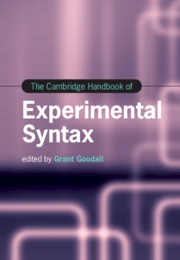Book contents
- The Cambridge Handbook of Experimental Syntax
- The Cambridge Handbook of Experimental Syntax
- Copyright page
- Contents
- Figures
- Tables
- Contributors
- Introduction
- Part I General Issues in Acceptability Experiments
- Part II Experimental Studies of Specific Phenomena
- Part III Experimental Studies of Specific Populations and Language Families
- Part IV Experimental Syntax beyond Acceptability
- 22 Theories All the Way Down
- 23 Eye-Tracking and Self-Paced Reading
- 24 Nothing Entirely New under the Sun: ERP Responses to Manipulations of Syntax
- 25 Corpus Studies of Syntax
- 26 Syntax and Speaking
- 27 Neuroimaging
- Index
- References
25 - Corpus Studies of Syntax
from Part IV - Experimental Syntax beyond Acceptability
Published online by Cambridge University Press: 16 December 2021
- The Cambridge Handbook of Experimental Syntax
- The Cambridge Handbook of Experimental Syntax
- Copyright page
- Contents
- Figures
- Tables
- Contributors
- Introduction
- Part I General Issues in Acceptability Experiments
- Part II Experimental Studies of Specific Phenomena
- Part III Experimental Studies of Specific Populations and Language Families
- Part IV Experimental Syntax beyond Acceptability
- 22 Theories All the Way Down
- 23 Eye-Tracking and Self-Paced Reading
- 24 Nothing Entirely New under the Sun: ERP Responses to Manipulations of Syntax
- 25 Corpus Studies of Syntax
- 26 Syntax and Speaking
- 27 Neuroimaging
- Index
- References
Summary
Recent developments in the experimental syntax program have challenged some of the standard practices for collecting and analyzing linguistic evidence. In doing so, the methodological and theoretical gap between other areas of language science has begun to close. It is more common than ever before for research in theoretical syntax to incorporate multiple methodologies in the same study. Online elicitation methods, adopted from psycholinguistics, have been the most visible new addition to the theoretical syntactician’s toolbox. Yet observational data, in the form of corpora, has begun to play a larger role in contemporary syntactic investigation. The aim of this chapter is to contextualize the evolving role of corpus studies in syntactic investigation as a methodology that can be used to externally validate results from other methods as well as generate hypotheses. I highlight theoretical and practical advantages of employing corpora in tandem with other methods and point to future directions where gains can still be made.
Keywords
- Type
- Chapter
- Information
- The Cambridge Handbook of Experimental Syntax , pp. 687 - 713Publisher: Cambridge University PressPrint publication year: 2021



